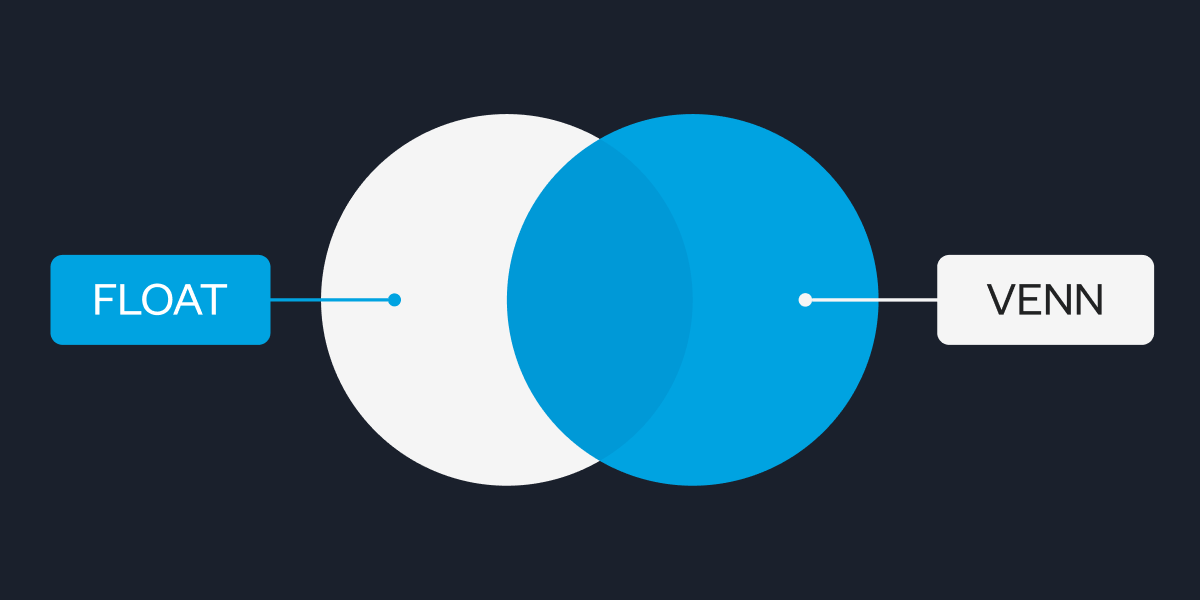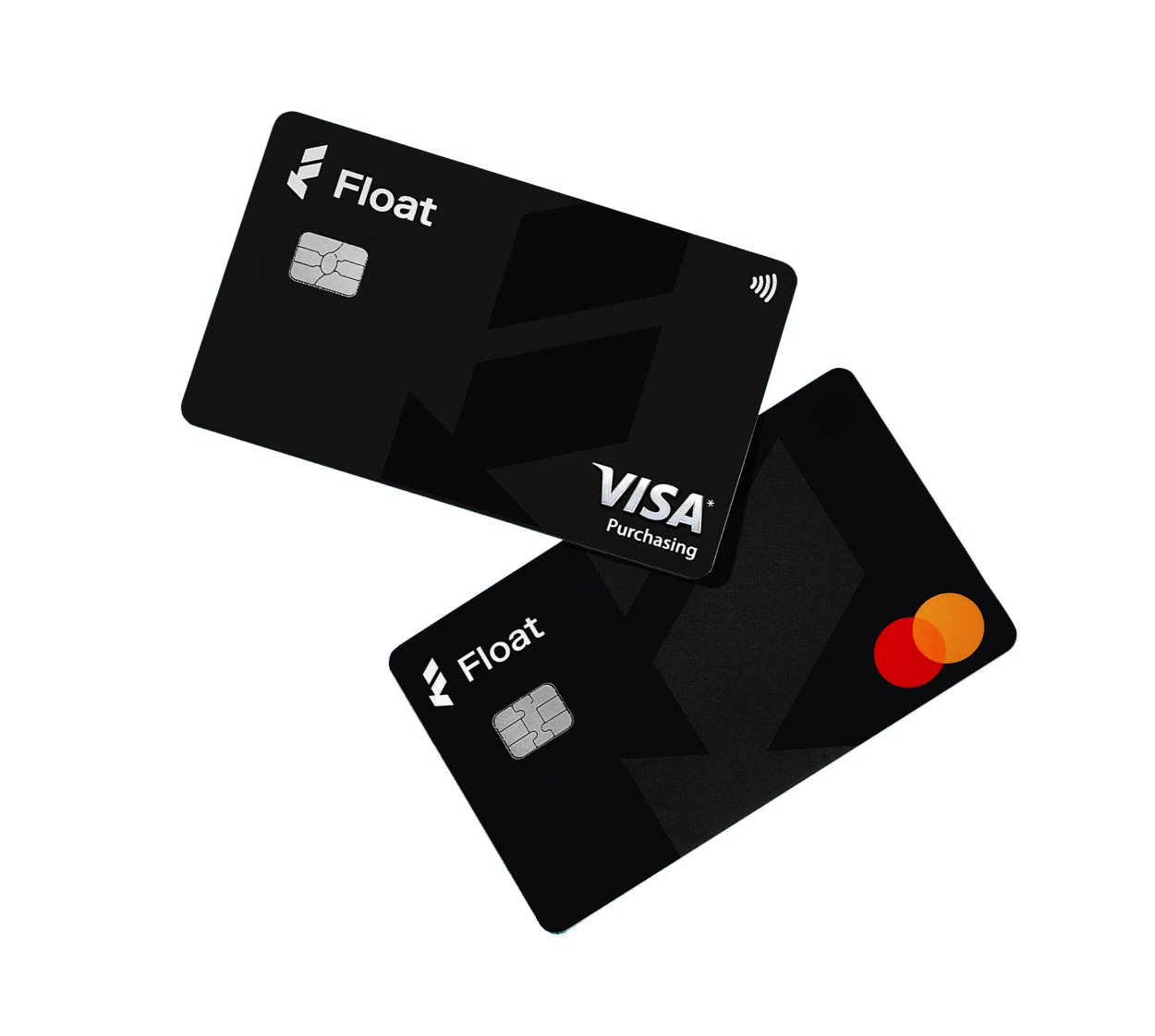Corporate Cards
Discover: Virtual Credit Cards for Canadian Businesses
Explore the benefits of virtual credit cards with Float. Discover how this modern payment solution enhances security and simplifies your financial transactions.
October 30, 2025

The future of secure online payments isn’t plastic—it’s virtual. Virtual credit cards let Canadian businesses shop, subscribe and pay vendors online without ever exposing their real financial information.
By adding an extra layer of security and control to your online payments, virtual credit cards are a game-changer for businesses looking to make purchases online with peace of mind.
In this article, we’ll dive into the world of virtual credit cards, exploring what they are, how they work and the numerous benefits they offer. By the end, you’ll have a clear understanding of why virtual cards are a smart choice for anyone who values security and convenience when shopping online.
What is a virtual credit card?
A virtual credit card is a secure, digital 16-digit card number that allows your business to make online purchases without exposing your main account details. Although a separate number is used, transactions you make with a virtual card still appear on your regular statement. This comes from your prepaid balance or your monthly charge limit. This gives teams the flexibility of a traditional card with added control and real-time visibility into spending.
How do virtual credit cards work?
When you request a virtual card number, your issuer generates a unique 16-digit number, expiration date and CVV that is tied to your account. You then use this virtual card number to make purchases online or over the phone, without revealing your physical card’s information. Depending on your needs, some virtual card numbers are for single use, while others can be used for multiple transactions.
Learn more about the different types of virtual cards.
Quick history of virtual cards for business expenses
Virtual cards first emerged in the early 2000s as a fraud protection tool for online shoppers. Their application quickly expanded into business environments as companies recognized their potential for managing expenses more securely and efficiently. By generating unique card numbers for specific transactions or users, virtual cards help reduce the risk of fraud and control employee spending.
The rise of e-commerce and digital payments has accelerated the adoption of virtual credit cards, especially in industries such as travel and insurance. E-commerce and SaaS and also led the way, using virtual cards for recurring payments like digital ads and subscriptions. The COVID-19 era further boosted the popularity of these cards, as remote-first businesses sought contactless and remote payment solutions.
Find the best credit card for ecommerce and retail companies in Canada.
What’s new with virtual credit cards in 2025
Virtual cards aren’t new. But the way Canadian businesses use them has changed dramatically. In 2025, Canadian companies have access to smarter, faster and more secure tools than ever before. The improvements aren’t just convenient. They shape how businesses control spend, protect funds and operate across borders.
Here’s what’s new in 2025:
1. Smarter controls: Finance teams can set detailed rules at the merchant, department or transaction level. This means recurring expenses like software or ads are easy to manage, while one-off purchases stay under control.
2. Stronger security: Providers now use advanced tokenization and AI-driven fraud detection to flag unusual activity in real-time, adding another layer of defence against rising cyber threats.
3. Global flexibility: With more Canadian businesses working internationally, no-FX-fee USD virtual cards are now the norm on platforms like Float. This reduces costs for cross-border purchases and simplifies reporting.
4. Faster setup: Traditional banks can take weeks to issue cards. Modern platforms now let you open accounts and start issuing unlimited CAD and USD cards in as little as one business day.
Many US-based fintechs only issue USD cards and require US bank accounts, forcing Canadian companies to absorb costly FX fees or create workarounds. Float is built in Canada for Canadian companies. It offers CAD and USD Visa and Mastercard options, CRA-compliant reporting and integrations with the accounting tools Canadian businesses already use like QuickBooks, Xero and Netsuite.
In 2025, virtual cards are more than just a secure way to pay online. They’ve become a core financial tool, helping businesses manage distributed teams, streamline expenses and stay competitive in a digital-first economy.
Virtual vs. physical cards
So what are the big differences between virtual and physical cards on a platform like Float? Let’s break down the differences.
| Feature | Virtual | Physical |
| No personal guarantee | ✅ | ✅ |
| Real-time spend insights | ✅ | ✅ |
| Recurring and temporary limits | ✅ | ✅ |
| Automatic receipt capture and matching | ✅ | ✅ |
| Instantly issued | ✅ | ❌ |
| Unlimited cards | ✅ | ❌ |
| Tap-enabled | ✅* *Through mobile wallet | ✅ |
**Conditions apply. Book a demo with our team for more details.
Benefits of using a virtual credit card
Now that you know the basics of virtual cards, let’s walk through some of their main advantages.
- Enhanced security: Virtual cards protect your real card number, reducing the risk of fraud and stolen information.
- Customizable controls: Many issuers allow you to set spending limits or expiration dates on virtual cards, giving you more control over online transactions.
- Convenience: Generate virtual cards in seconds online without the hassle of waiting for a physical card to arrive in the mail.
- Privacy: Each virtual number is unique, helping limit data tracking by advertisers and keeping your personal details private.
Security benefits: Virtual vs. physical credit cards
Security is one of the biggest reasons businesses are turning to virtual credit cards. Unlike physical cards, which can be lost, stolen or skimmed, virtual cards exist only in a secure digital format. Each card number is unique, making it significantly harder for fraudsters to exploit. For finance teams in Canada, this added protection helps prevent fraud before it ever reaches the books.
One of the strongest security features of virtual cards is their flexibility. You can issue cards that work once, or cards tied to specific merchants or recurring payments. That means you contain the risk if something goes wrong. In contrast, physical cards can expose the entire account when compromised (e.g. if a company is card sharing), forcing a full cancellation and reissue.
Key security benefits
Some other key security benefits of virtual cards include:
- Single-use numbers: Ideal for one-time payments, as they expire immediately after use.
- Custom limits: Set strict caps by vendor, category or transaction type.
- Reduced exposure: A compromised virtual number can be shut down instantly, without affecting other spending.
- Real-time alerts: Unusual charges trigger immediate notifications, letting finance teams act quickly.
Physical cards from traditional providers lack these built-in controls. If a wallet is stolen or card data is skimmed, you have to cancel the entire card. This causes delays in employee spending and creates reconciliation headaches. However, virtual cards minimize disruption. Cancel the compromised number, immediately issue a new one and the rest of your company’s payments keep running smoothly.
For Canadian businesses navigating higher online transaction volumes and rising fraud attempts, virtual cards provide a powerful layer of defence. They don’t just make payments safer, they also give finance leaders confidence that company funds are being spent securely and with full visibility.
Want more ways to protect your business? Explore our full guide on credit card fraud prevention strategies.
Virtual credit cards for remote Canadian teams
Remote and hybrid work are still common for many Canadian companies. Employees may be spread across provinces, contractors abroad and finance teams are often lean. Traditional corporate card programs—where employees wait weeks for a physical card—don’t match this reality. Virtual cards do.
With virtual cards, finance teams can issue cards instantly from anywhere. That means:
- A new hire in Vancouver can be equipped with a company card on their first day.
- A contractor in Montreal can be given a project-specific card for vendor payments.
- A marketing manager in Toronto can run digital ad campaigns without needing to borrow someone else’s card.
No delays, no card-sharing and no more waiting on the mail (hello, postal strikes).
Each card can be tied to a role, project or subscription, with limits set upfront. Finance leaders see spend in real time, rather than waiting until the end of the month. That means fewer bottlenecks and better visibility across the organization.
Virtual cards bridge the gap for Canadian businesses with distributed or international teams, giving employees the flexibility to move fast, and finance leaders the visibility to keep spend on track.
How to get a virtual credit card in Canada
To get started with virtual credit cards, check if your current credit card issuer offers this feature. If so, simply log into your online account or mobile app to generate a virtual number. Unfortunately, Canada’s major banks do not offer virtual cards for small businesses. And, while there are a growing number of fintech providers who do, their offerings may require your business either A) to meet certain criteria (eg. be in business for a certain amount of time or be a certain size) or B) issue only USD cards because they’re a US-based provider. The good news is that Float is built in Canada and offers best-in-class virtual card solutions for businesses.
How to implement virtual credit cards in your business
Rolling out virtual credit cards is easier than most finance teams expect. Unlike traditional corporate card programs that can take weeks, modern providers let you set up accounts and issue cards in less than a day. With the right approach, you can have your business running on virtual cards quickly and with minimal disruption.
The first step is choosing the right provider. For Canadian businesses, this often means looking for a platform that:
- Offers both CAD and USD cards (most US providers only offer USD)
- Integrates with local accounting tools like QuickBooks and Xero
- Doesn’t require a personal guarantee or credit checks, which Canadian banks often demand
- Doesn’t require a US entity or bank account
- Provides unlimited card issuance at no extra cost
Finance leaders should create clear policies once they have a platform selected. Decide who gets access to cards, when new cards are created and what limits apply—for example, vendor payments. Setting these rules early ensures everyone uses cards responsibly and within budget.
The next step is to integrate virtual cards with your expense management and accounting systems. This way, every transaction is categorized automatically, receipts are matched in real time and reconciliation happens faster. Employees should also be trained on how to use their cards: what expenses are allowed, how to upload receipts and how to request new cards.
By following these steps, Canadian businesses can roll out virtual cards with confidence—without relying on US solutions that don’t fit their banking or compliance needs.
For more, discover more on how to build a business credit card policy that fits your company.
Using your virtual credit card
Using a virtual credit card is essentially the same as using your regular card for online purchases. Simply shop online as usual, inputting your virtual card number, expiration and CVV at checkout instead of your physical card details. If you have recurring payments, you may want to generate a virtual card that doesn’t expire after a single use.
Keep in mind that virtual cards aren’t accepted for all in-person purchases or transactions that require your physical card, such as picking up tickets or checking into a hotel. However, if you need to make a return, the refund will still be credited back to your account even if you used a single-use virtual number.
Virtual cards vs. digital wallets
Both virtual cards and digital wallets help keep your actual card number private during transactions, but they work in slightly different ways. Digital wallets like Apple Pay and Google Pay enable you to make payments in-person or online using your mobile device. In contrast, virtual card numbers are typically intended for online use only. However, you can often store your virtual credit card in your digital wallet for easy access and added security when shopping on your phone or computer.
Virtual credit card integration with Canadian accounting software
One of the biggest advantages of virtual credit cards is their seamless integration with accounting tools. For Canadian businesses using QuickBooks, Xero or Netsuite, this connection turns what used to be hours of manual reconciliation into a fully automated process. Instead of chasing receipts or entering transactions by hand, everything flows directly into your books.
With the right provider, you get:
- Real-time transaction sync: Purchases appear instantly in your accounting platform.
- Automatic receipt matching: Employees upload a receipt once and the system attaches it to the right transaction.
- Audit-ready records: Every payment is tracked and categorized, making month-end and tax season much smoother.
This automation doesn’t just save time. It also reduces errors. Manual data entry is prone to mistakes and misplaced receipts can create compliance headaches. Additionally, US-based virtual card providers often do not prioritize Canadian integrations. That means QuickBooks or Xero Canadian users usually face broken connections or workarounds. By using virtual cards designed for Canadians that link directly with your accounting software, finance teams can be confident that records are complete and accurate.
For a deeper dive into how automation can save time and reduce errors, check out our guide to credit card expense management.
Integration also makes it easier to keep spending under control. Dashboards show exactly where money is going, whether that’s to subscriptions, digital advertising or cross-border vendor payments. For Canadian companies that need to manage both CAD and USD expenses, having all transactions consolidated in a single central system simplifies oversight and reporting.
The result is a finance process that feels lighter and more efficient. Instead of spending hours cleaning up spreadsheets, your team can focus on higher-value work like forecasting and strategy.
Discover how Float’s corporate cards platform empowers Canadian businesses.
Choosing the right corporate virtual card in Canada: Float
When deciding on a credit card with virtual card capabilities, consider factors like rewards, benefits and Float features, in addition to the ease of generating virtual numbers. Look for a card and issuer that makes it simple to create virtual cards, with options to set controls like spending limits and expiration dates. If you’re a business owner, choosing a corporate card with robust virtual card features can help manage employee spending and prevent fraud.
Try Float for free
Business finance tools and software made
by Canadians, for Canadian Businesses.Virtual credit cards offer a secure and convenient way to shop online, giving you greater control over your transactions and peace of mind knowing your sensitive information is protected. Join the growing number of savvy consumers and businesses who trust us to provide innovative payment solutions tailored to their needs.
Frequently Asked Questions
Virtual cards are the same as a traditional physical card with the exception that the card number for these cards is presented digitally. You can create and cancel virtual cards for any purchase and set custom limits on a per-card level to avoid overcharges from the vendors.
Float’s virtual cards are excellent for recurring subscription expenses, digital ad spend and one-off small employee purchases, as they can be added into Apple or Android Wallet and deleted once the purchase is complete. Float’s Essentials plan offers unlimited virtual cards and less than 10 minutes account application time.
Visa issues float’s virtual cards for CAD cards and Mastercard for USD spending. They offer direct 1% cash back on all categories after the first $25,000 of monthly spend. Float operates on a Charge Card or Prepaid funding model. The prepaid model offers up to 4% on CAD or USD balances ≥ $50,000 (up to $1M), 2% below $50,000,, with no cash lockups, and account opening is completed in under 24 hours.
Signing up for Float takes under 10 minutes and can be done entirely online. Float does not require any personal guarantees and does not perform credit checks to open your account.
Float is Free to use on our Essentials plan, where you will be able to issue unlimited virtual CAD/USD cards, earn up to 4% interest on deposits, reimburse employees and pay vendor bills. If you need more sophisticated functionality, like over 20 physical cards, Netsuite integration, or an API solution, consider our paid Professional and Enterprise plans.
Float offers Charge Card and Prepaid funding models. You can apply* for unsecured, 30-day credit terms with high limits up to $3M, no credit checks and personal guarantees. Both models offer up to 4% interest on all deposits, with no cash lockups, and account opening is completed in under 24 hours.
Unlike traditional cards that encourage spend, Float is the only corporate card in Canada that helps businesses spend less. Through a combination of financial rewards like our 1% cashback for spend above $25,000, up to 4% interest on deposits, no FX fees with our USD cards and time savings of at least 8 hours per employee, Float customers save an average of 7% on their spend.
Written by
All the resources

Expense Management
Float vs Venn: Which Solution Fits Your Business?
What's right for your business, Float or Venn? This article dives into the pros and cons of each, as well
Read More
Cash Flow Optimization
How to Make EFT Payments in Canada: Complete 2025 Guide
Learn how to initiate EFT Payments as a Canadian Business and innovative solutions available on the market, like Float, that
Read More
Cash Flow Optimization
Cash Flow Management for Canadian Businesses: 2025 Strategic Guide
Unlock business growth with our ultimate guide to understanding and improving cash flow in your business. Learn key strategies and
Read More






